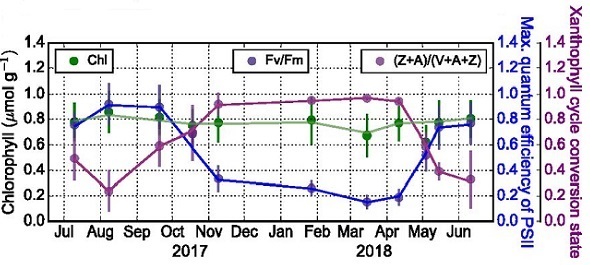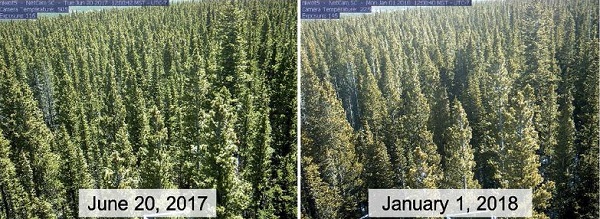Documentation Revision Date: 2019-11-21
Dataset Version: 1
Summary
The PAM fluorometry system was a portable photosynthesis system (LI-6800F, LI-COR) equipped with the standard broadleaf chamber and control of temperature, humidity, and incident light. Measurements of Fq'/Fm' were made were made on sun foliage from the canopy access towers. For pine, one to two fascicles were inserted into the chamber while attached to the branch. For spruce, branch/needle geometry prevented measurements with this chamber on intact branches, so 8-10 needles were detached from the branch and affixed to adhesive tape before placing in the leaf chamber.
There is one data file in comma-separated (.csv) format with this dataset.

Figure 1. Chlorophyll a+b concentration relative to dry mass (green), maximum quantum efficiency (Fv/Fm) measured with a fluorimeter (blue), and dark-adapted xanthophyll cycle conversion state (purple) ([Zeaxanthin+Antheraxanthin]/[Violaxanthin+Antheraxanthin+Zeaxanthin]) sampled at monthly intervals. All needle leaf measurements represent the mean and 1 SE of both Engelmann spruce and lodgepole pine samples during each 2 - 3 day sampling period. Refer to the related datasets for pigment concentrations. Figure from Magney et al. (2019).
Citation
Bowling, D.R., and B.A. Logan. 2019. Conifer Needle Chlorophyll Fluorescence, Niwot Ridge, Colorado, USA, 2017-2018. ORNL DAAC, Oak Ridge, Tennessee, USA. https://doi.org/10.3334/ORNLDAAC/1722
Table of Contents
- Dataset Overview
- Data Characteristics
- Application and Derivation
- Quality Assessment
- Data Acquisition, Materials, and Methods
- Data Access
- References
Dataset Overview
This dataset provides chlorophyll fluorescence measurements made on pine and spruce needle tissues at the Niwot Ridge AmeriFlux Core site (US-NR1) near Nederland, Colorado, USA, during the summers of 2017 and 2018. Two types of measurements were made using pulse-amplitude-modulation (PAM) fluorometry: the photosystem II (PSII) operating efficiency in the light (Fq'/Fm' at variable light levels), and the maximum quantum efficiency of PSII photochemistry (Fv/Fm) on dark-acclimated tissues. Chlorophyll fluorescence measurements were made to determine seasonality of photosynthetic performance at the needle level.
The PAM fluorometry system was a portable photosynthesis system (LI-6800F, LI-COR) equipped with the standard broadleaf chamber and control of temperature, humidity, and incident light. Measurements of Fq'/Fm' were made were made on sun foliage from the canopy access towers. For pine, one to two fascicles were inserted into the chamber while attached to the branch. For spruce, branch/needle geometry prevented measurements with this chamber on intact branches, so 8-10 needles were detached from the branch and affixed to adhesive tape before placing in the leaf chamber.
Project: Carbon Monitoring System (CMS)
The NASA Carbon Monitoring System (CMS) is designed to make significant contributions in characterizing, quantifying, understanding, and predicting the evolution of global carbon sources and sinks through improved monitoring of carbon stocks and fluxes. The System will use the full range of NASA satellite observations and modeling/analysis capabilities to establish the accuracy, quantitative uncertainties, and utility of products for supporting national and international policy, regulatory, and management activities. CMS will maintain a global emphasis while providing finer scale regional information, utilizing space-based and surface-based data and will rapidly initiate generation and distribution of products both for user evaluation and to inform near-term policy development and planning.
Related Publication:
Magney, T.S., D.R. Bowling, B.A. Logan, K. Grossmann, J. Stutz, P.D. Blanken, S.P. Burns, R. Cheng, M.A. Garcia, P. Kohler, S. Lopez, N.C. Parazoo, B. Raczka, D. Schimel, and C. Frankenberg. 2019. Mechanistic evidence for tracking the seasonality of photosynthesis with solar-induced fluorescence. Proceedings of the National Academy of Sciences 116:11640–11645. https://doi.org/10.1073/pnas.1900278116
Related Datasets: Leaf-level characteristics were measured at a conifer forest in Niwot Ridge, Colorado, including chlorophyll fluorescence (this dataset) and needle pigment composition (Bowling & Logan, 2019b). The leaf-level data was used in part to help define and validate parameters within an earth system model that was used to simulate leaf and canopy level fluorescence (Raczka et al., 2019).
Raczka, B.M., A. Porcar-Castell, T. Magney, J. Lee, P. Kohler, C. Frankenberg, K. Grossmann, B. Logan, J. Stutz, P.D. Blanken, S.P. Burns, H.F. Duarte, X. Yang, J.C. Lin, and D. Bowling. 2019. CLM Simulated Solar-Induced Fluorescence, Niwot Ridge, Colorado, USA, 1998-2018. ORNL DAAC, Oak Ridge, Tennessee, USA. https://doi.org/10.3334/ORNLDAAC/1720
Bowling, D., and B. Logan. 2019b. Conifer Needle Pigment Composition, Niwot Ridge, Colorado, USA, 2017-2018. ORNL DAAC, Oak Ridge, Tennessee, USA. https://doi.org/10.3334/ORNLDAAC/1723
Acknowledgements:
This study was supported by NASA’s Carbon Monitoring System Program, under grant NNX16AP33G
Data Characteristics
Spatial Coverage: Niwot Ridge, Colorado, USA, AmeriFlux Core Site US-NR1
Spatial Resolution: Point
Temporal Coverage: 2017-07-10 to 2018-06-11
Temporal Resolution: Monthly
Study Area: (all latitudes and longitudes given in decimal degrees)
|
Site |
Westernmost Longitude |
Easternmost Longitude |
Northernmost Latitude |
Southernmost Latitude |
|---|---|---|---|---|
|
Niwot Ridge, CO, AmeriFlux Core Site US-NR1 |
-105.55 |
-105.55 |
40.03 |
40.03 |
Data File Information
There is one data file in comma-separated (.csv) format with this dataset: NiwotRidge_coniferneedle_fluorescence_2017_2018.csv. This file provides two types of chlorophyll fluorescence measurements made on pine and spruce needle tissues using pulse-amplitude-modulation (PAM) fluorometry: the photosystem II (PSII) operating efficiency in the light (Fq'/Fm' at variable light levels), and the maximum quantum efficiency of PSII photochemistry (Fv/Fm) on dark-acclimated tissues. Missing values are represented as -9999.
Table 1. Variables in the data file
| Variable | Units | Description |
|---|---|---|
| sample_date | YYYY-MM-DD | Sampling date |
| sample_id |
Sample ID: YYMMDD Xn Bn Rn (Examples: 170710 P9 B2 R2 and 180504 P10 B1 R4) Where: YYMMDD = date of sampling Xn = tree species and tree number
Bn = branch number (multiple branches were sampled on the same tree) Rn = replicate number (same branch and date). Replicates at different needle illumination levels. |
|
| latitude | decimal degrees | Latitude of the Niwot Ridge AmeriFlux site study area |
| longitude | decimal degrees | Longitude of the Niwot Ridge AmeriFlux site study area |
| tree_species | Pine or Spruce | |
| pulse_time | hhmm | Time of day when measurement began |
|
Pulses in light |
||
| Fm_prime (Fm′) | Maximal fluorescence from light-adapted leaf | |
| Fs | Steady state fluorescence in the light | |
| Qin | mmol photons m-2 s-1 | Light level applied (mmol photons m-2 s-1) |
| leaf_temp | Deg C | Leaf temperature |
|
After dark pulses |
||
| Fv_prime (Fv′) | Variable fluorescence in the light following darkening | |
| Fs | Steady state fluorescence in the light following darkening | |
| Fo_prime (Fo′) | Minimal fluorescence in the light following darkening | |
|
After dark adapting |
||
| Fm | Maximal fluorescence from dark-adapted leaf | |
| Fo | Minimal fluorescence from dark-adapted leaf |
Application and Derivation
The study could be useful to climate change studies and the estimation of gross primary production (GPP) particularly when combined with SIF and pigment concentration data from the related datasets listed in Section 2 of this guide. Accurately determining the timing of seasonal GPP onset and cessation in evergreen forests is difficult. The data from this study indicates that the needles retained chlorophyll year-round despite cold temperatures and high light in winter.
Quality Assessment
Due to canopy structure, a limited number of trees were accessible from the towers, preventing more extensive replication. This also limited sampling to P. contorta and P. engelmannii needles. Species were pooled together to better match the FOV of tower- and satellite-based SIF retrievals (related dataset); however, no significant difference was observed between the two species at any time during the season (Magney et al., 2019).
Data Acquisition, Materials, and Methods
Study Location
This research was conducted at a high-elevation conifer forest in Colorado, U.S.A (the Niwot Ridge AmeriFlux Core Site US-NR1, 40.03°N, 105.55°W, 3,050 m elevation), over the annual period from summer 2017 to summer 2018. The forest is composed of three dominant evergreen needleleaf species: lodgepole pine (Pinus contorta Douglas ex Loudon), Engelmann spruce (Picea engelmannii Parry ex Engelm.), and subalpine fir (Abies lasiocarpa (Hook.) Nutt.). The climate includes cold winters with a persistent snowpack from October-November to May-June.

Figure 2. Phenocam (webcam) images of the canopy at Niwot Ridge, CO where the data were collected during different seasons (Magney et al., 2019).
Experimental Design
To determine seasonality of photosynthetic performance at the needle level, physiological measurements were made on sun foliage from two canopy-access towers near the main flux tower, and in the laboratory on branches collected from those towers, every 4-8 weeks over the annual cycle. These included SIF, chlorophyll fluorescence and needle pigment composition (refer to the related datasets in the Overview Section of this document for SIF and pigment data) for pine and spruce trees.
Needle-level Chlorophyll Fluorescence
Chlorophyll fluorescence was measured on pine and spruce trees using pulse-amplitude-modulation (PAM) fluorometry using a portable photosynthesis system (LI-6800F, LI-COR) equipped with the standard broadleaf chamber and control of temperature, humidity, and incident light. Two types of measurements were made, the photosystem II (PSII) operating efficiency in the light (Fq'/Fm' at variable light levels), and the maximum quantum efficiency of PSII photochemistry (Fv/Fm on dark-acclimated tissues). Notation is consistent with Baker (2008).
Measurements of Fq/Fm' were made from the canopy access towers as follows:
For pine, 1-2 fascicles were inserted into the chamber while attached to the branch. Spruce branch/needle geometry prevented measurements with this chamber on intact branches, so 8-10 needles were detached from the branch and affixed to adhesive tape before placing in the leaf chamber. The orientation of the needles in the chamber was not controlled (adaxial versus abaxial). Prior to a measurement, ambient air temperature and light level were measured, and leaf temperature and incident light in the leaf chamber were set to match air temperature and 40% relative humidity. After stabilization based on measured gas exchange parameters (minimum of 5 minutes), a saturation pulse was provided to calculate Fq'/Fm'. This was repeated for incident photosynthetically active radiation (PAR) of 200, 500, and 1600 mmol photons m-2 s-1 to provide light response curves.
To measure Fv/Fm, the distal 10-15 cm of branches were cut and stored darkened in aluminum foil with a moistened paper towel at ambient temperature for several hours. Tissue for this was separate from the measurements in the light. Dark-acclimated samples were measured in the lab provided a saturation flash (Magney et al., 2019).
Data Access
These data are available through the Oak Ridge National Laboratory (ORNL) Distributed Active Archive Center (DAAC).
Conifer Needle Chlorophyll Fluorescence, Niwot Ridge, Colorado, USA, 2017-2018
Contact for Data Center Access Information:
- E-mail: uso@daac.ornl.gov
- Telephone: +1 (865) 241-3952
References
Baker, N.R. 2008. Chlorophyll Fluorescence: A Probe of Photosynthesis In Vivo. Annual Review of Plant Biology 59:89–113. https://doi.org/10.1146/annurev.arplant.59.032607.092759
Magney, T.S., D.R. Bowling, B.A. Logan, K. Grossmann, J. Stutz, P.D. Blanken, S.P. Burns, R. Cheng, M.A. Garcia, P. Kohler, S. Lopez, N.C. Parazoo, B. Raczka, D. Schimel, and C. Frankenberg. 2019. Mechanistic evidence for tracking the seasonality of photosynthesis with solar-induced fluorescence. Proceedings of the National Academy of Sciences 116:11640–11645. https://doi.org/10.1073/pnas.1900278116